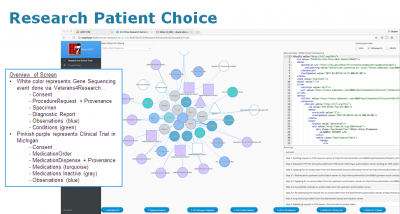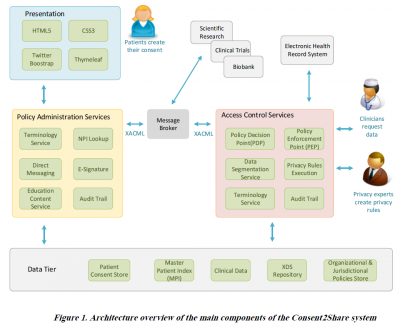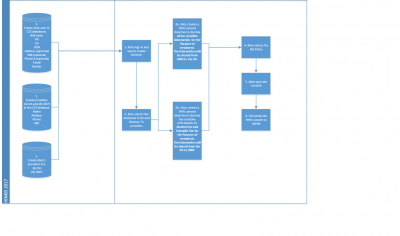HIMSS 2017 Patient Choice
Contents
HIMSS 2017 Orlando Top Story
- FHA’s Patient Choice Demonstrations at HIMSS 2017 captures attention. With a storyline based on ONC Patient Choice pilots, teams from the Veteran Health Administration (VHA or VA), Michigan Health Information Network Shared Services (MiHIN) and the Substance Abuse and Mental Health Administration] (SAMHSA) successfully demonstrated emerging technology and standards applied to meaningful patient choice for the use and disclosure of their own health information.
- Sponsors included the HHS National Privacy Office, Health Level 7 with support from the USPS, and Patient Privacy Rights.
- In the demonstration, Alice, a fictional disabled veteran, enables her treatment and research providers to apply and comply with laws for specially protected information such as 42 CFR Part 2 and Title 38 Section 7332.
- MiHIN mediates coordination of Alice’s community based behavioral health through the VA Choice Program with her VA providers, facilitated by SAMHSA’s Consent2Share consent directive platform. MiHIN uses HL7 Security Label “Privacy Tags” with an innovative internal rules engine approach to enforce Alice’s consents.
- Next, Alice’s participation in the Veterans4Research Program[1] is facilitated by a FHIR Research Informed Consent. VA uses a newly proposed Patient/Provider Centered Consent approach to authorization to enable Alice’s enforcement of her VA privacy preferences using her own HL7 FHIR and OAuth 2.0 equipped Authorization server.
- To assure that Alice’s providers have confidence in the trustworthiness of her research data, FHIR Provenance is used to track its lifecycle.
- The FHA Interoperability Showcase reported record traffic this year through the FH A vignette and other FHR stations. [HIMSS had 42,000 attendees at the showcase this year. Of those 7,500 visited the Interoperability showcase. That is a 4,000 person increase from last year’s numbers for interop showcase visitors.] Many reported to have been directed to these demonstrations.
- The vignettes ran seamlessly and seemed to catch the viewers’ imagination. The discussions led to multiple deeper dives among interested parties while those who just wanted to get an overview were satisfied with the high level walk-throughs.
- Components of this demonstration are in production or being piloted by the participating organizations, and their architects and developers, as well as those involved with development of these standards, were be on hand to answer audience questions. Participating teams were already brain-storming on HIMSS v-next based on the ONC Patient Research Choice Technical Project.
[1] Modeled after but not affiliated with the Veteran Administration’s Million Veteran Program.
Veteran Alice's Story
- Alice is a Veteran and lives in Michigan. After a tour in Afghanistan, Alice is diagnosed with post-traumatic stress and substance abuse disorders in part due to combat. Alice receives treatment from the U.S. Department of Veterans Affairs (VA) and her Michigan community mental health clinic through the Veteran’s Choice Program. Alice consents to share her specially protected health information between the VA and the community mental health clinic for care coordination.
- To do so, Alice logs on to Consent2Share. She wants to provide authorization (1) for the VA to share her substance abuse treatment records with the community mental health clinic, and (2) to share all of her information from her community mental health clinic with the VA.
She wants her mental health clinic to have a good understanding of her substance abuse treatment. Using the “Add Providers” feature, Alice adds both providers to her Consent2Share account. She can also select behavioral health information that she does not want the community mental health clinic to view.
- Alice chooses to create two consents for the purpose of treatment. In the first consent, she wants to share only her VA substance abuse records with the local mental health clinic. Next, she creates a consent for her mental health clinic to share all of her mental health information with the VA. Alice verifies the information she has entered.
Now, Alice wants to review her consents. To do so, she selects “Try My Policy” and reviews her choices. After she reviews her choices, she can sign the consent electronically online using Consent2Share. Once she signs the consent, she can view it online and download it as a PDF file.
- As a native Spanish speaker, Alice can also choose to use the Consent2Share Spanish translation. This option allows her to create and manage her consents in the language with which she is comfortable, without sacrificing any features or functionality.
From a technical perspective, there are two key steps:
- First, the VA electronically stores Alice’s substance abuse treatment records in their health information exchange or HIE
- Second, after Alice provides her written consent online using Consent2Share, the local mental health clinic can electronically retrieve Alice’s substance abuse treatment records from the VA’s HIE
- Using the Consent2Share application, Alice is able to visit her local mental health clinic and ensure that her substance abuse treatment will continue uninterrupted.
Presentations, Use Case, Technical Documentation
Previous Demonstations upon which the HIMSS 2017 Demonstration builds
September 2016 FHIR Connectathon
- Enforcing FHIR Consents using a Third-Party Authorization Server demonstrated at the HL7 September 2016 FHIR Connectathon shows an environment where a FHIR OAuth server and the HL7 Healthcare Privacy and Security Classification System for security labels and data segmentation.
HIMSS 2017 Technical Presentations
- HL7 Cascading UMA OAuth video - Duane Decouteau
- Cascading OAuth and Patient Right of Access
- Animated Cascading OAuth Flows
- Cascaded Authorization Detailed Flows
- HCS on FHIR Demo Mohammad Jafari
- Cascading OAuth for Patient Consent and Patient Right of Access Use Cases
- Cascading UMA/Oauth Demonstration
- Privacy on FHIR HIMSS 2015 Demonstratrion
HIMSS 2017 Research Patient Choice
- Patient Choice Demo - Provenance for Research
- HIMSS Research Provenance Demonstation
- HIMSS Research Data Flows
Provenance is critical to Research. The data flows from clinical care in translational Clinical Trials, and then through multiple paths for secondary research use. In a Learning Health System the secondary research findings should feed back into the initial clinical trial and should lead the patient to other beneficial clinical trials as part of precision medicine. Additionally, patient generated health data should be flowing into the research pipeline. These multiple data sources need to be tracked so that automated integration into research records can be done based on confidence metrics derived from provenance.
Consent on FHIR
For previous HIMSS and other collaboration demonstrations and videos




